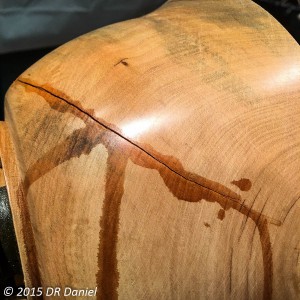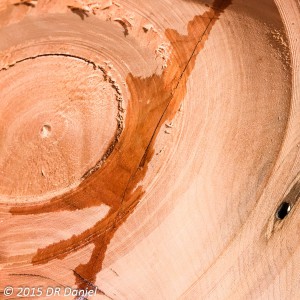I dropped a large dead cherry tree in the woods today and just had to test-turn a piece. I had stacked and treated most of the logs to give them time to stabilize. I ripped one of the logs into a pair or turning blanks and mounted one on the lathe. This wood turns like a dream. It cuts very easy, yet has enough strength to minimize tear-out. Even in this freshly cut state, the color is very pronounced. (Cherry takes a few years in sunlight to get that rich, deep cherry color).
I rough-turned the piece and quickly established the outside shape – a simple footed ogee curve. I ran through the sanding grits, followed by my polishing steps. Finish will come later when the piece is complete, inside and out.
After finishing the outside, I flipped it around and started hollowing out the bowl. As I was turning, I noticed a subtle  change in the tone (sound, not color) of the wood. It was similar to what I would expect as I thin a piece down to thinner and thinner. But this was periodic. I stopped the lathe thinking the chuck may have loosened a bit and discovered a threatening split that spanned across the 75% of the bowl. I reached for the CA glue to stabilize the split, a common requirement with found wood. Using thin CA, the crack wicks in the glue rapidly, providing stability to the piece. For those readers that don’t turn wood, this process is pretty common, especially with “found” wood such as this. For wider cracks, I would rub in some fine wood dust to act as a filler.
change in the tone (sound, not color) of the wood. It was similar to what I would expect as I thin a piece down to thinner and thinner. But this was periodic. I stopped the lathe thinking the chuck may have loosened a bit and discovered a threatening split that spanned across the 75% of the bowl. I reached for the CA glue to stabilize the split, a common requirement with found wood. Using thin CA, the crack wicks in the glue rapidly, providing stability to the piece. For those readers that don’t turn wood, this process is pretty common, especially with “found” wood such as this. For wider cracks, I would rub in some fine wood dust to act as a filler.
It’s clear that a substantial crack like this would easily lead to a fragmented bowl as I turned thinner and deeper on the inside. I was very happy to catch this before it became an event! Being aware that the sounds and the tone of the wood gives us a lot of clues about what is going on with our turnings. Radial cracks such as this don’t normally cause issue for me, as I typically turn a bowl oriented differently than this. I typically turn a bowl with the foot towards the center of the log, and the rim near the outside of the log. This was different, as I was turning the rim towards the center and foot towards the bark. In this orientation, the crack compromises the base of the bowl instead of presenting itself as a simple crack in the wall.
I let it set for a bit (a nice cup of coffee was in order) before returning to hollow out the interior. Checking where I was at on the inside surprised me a bit; the CA glue flowed through the thickness of the bowl (over 35-40mm at this point). I found it both fascinating and unsettling that the glue had been flowing through that much wood. Unsettling that the gap was that pervasive through the piece. As mentioned earlier, it was unique (for me), that it compromised the base of the bowl, and up towards the rim. So here’s the question: Would you continue to finish out this piece, or is this one that goes in the scrap pile?
So here’s the question: Would you continue to finish out this piece, or is this one that goes in the scrap pile?
For the record, I’m letting the wood stabilize for awhile before tooling any further, but I do plan on finishing out the piece. And yes, I do wear a face shield at ALL times. Just like when I’m on my motorcycle, it’s ATGATT (All The Gear, All The Time). It’s times like this that underscores the importance of safety gear, and listening to your wood.
<Update>Check out the results here.

2 thoughts on “Got Glue?”